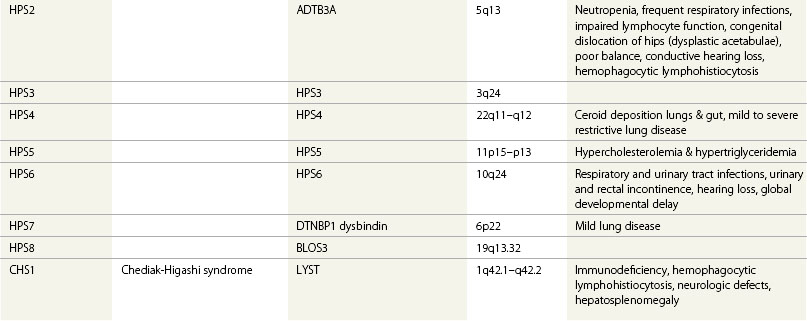Chapter 40 Albinism
The main pigmentation genes
• Genes controlling development and differentiation of pigment cells (melanocytes). Mutation of these genes, such as MITF, may be associated with deafness, but not usually with ocular defects.
• Genes encoding components of melanosomes (pigment producing organelles within melanocytes). Mutation of these genes affects skin pigmentation and vision pathways producing albinism.
• Genes controlling biogenesis of lysosome related organelles (LROs) including melanosomes. Mutations cause Hermansky-Pudlak (HPS) and Chediak-Higashi (CHS) syndromes which have ocular features of albinism.
• Genes involved in organelle transport, including LROs. Mutations cause Griscelli’s immunodeficiency syndromes and Elejalde’s syndrome, both with normal eyes.
• Genes involved in switching between eumelanin (brown and black pigment) and pheomelanin (red and yellow pigment) such as melanocortin 1 receptor protein alter the phenotype of albinism but mutation does not cause albinism.
What is albinism?
Albinism is not a single condition, but a group of disorders caused by mutation of one or more genes involved in the function of the melanosome – a specialized organelle involved in melanin pigmentation.1 In man, there are specialized melanosomes in cerebral astrocytes and melanolysosomes in retinal pigment epithelium and iris. Individuals with albinism are distinguished from blondes by their ocular features.
Why a diagnosis is important
It is important to make the diagnosis of albinism as early as possible to:
• Avoid concern that a child will be blind. Delayed vision maturation is common in albinism (see Chapter 4). Nystagmus is often misinterpreted as roving eye movements. The prognosis for many children with albinism is of severe vision impairment, with corrected distance acuity of logMAR 1.0. However, they will see to read, even small print, albeit at a reduced distance and be able to navigate well. Except in one very rare form albinism is not degenerative.
• Avoid concern that nystagmus is a sign of neurologic or progressive retinal disease. The majority will be healthy and have no intellectual impairment.
• Give advice on promotion of best vision outcome, ocular comfort in bright lighting, and skin protection.
• Be aware of the subtypes that may be associated with impaired platelet and immune function. Rarely, an infant will present with features of albinism and retinal hemorrhages after minimal head trauma, even birth, with Hermansky-Pudlak albinism. Standard coagulation screening may miss this diagnosis.2
Classification of albinism
The most useful classification of albinism is where the defect is of a gene product expressed only in the melanosome or where other related organelles also malfunction (Table 40.1). The former individuals have a non-progressive ocular disorder and lack photoprotection, yet the latter may have serious systemic problems.





